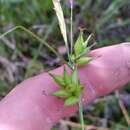Description
provided by eFloras
Culms obtusely trigonous in cross section, 45–100(–160) cm, smooth. Leaves: ligules 3–12 mm, mostly longer than wide; blades yellowish or light green, widest leaves 1.8–6 mm wide, smooth or sometimes papillose, especially distally. Inflorescences (3–)5–30(–45) cm; proximal (1–)2–3 spikes pistillate, erect or the proximal spreading, aggregated or the proximal sometimes remote, ovoid to short-cylindric. Pistillate scales ovate, 1/3–2/3 as long as perigynia, apex acute to acuminate. Anthers 2.3–5.1 mm. Perigynia spreading or the proximal somewhat reflexed, yellowish green, 22–34-veined, inflated, ovate to narrowly ovate, 6.4–10.7 × 2–3.5 mm, 2.6–3.9 times as long as wide, apex contracted; beak 1.3–3 mm. Achenes 2.8–3.6 × 1.6–2.2 mm.
- license
- cc-by-nc-sa-3.0
- copyright
- Missouri Botanical Garden, 4344 Shaw Boulevard, St. Louis, MO, 63110 USA
Distribution
provided by eFloras
Ala., Fla., Ga., La., Miss., N.C., S.C.
- license
- cc-by-nc-sa-3.0
- copyright
- Missouri Botanical Garden, 4344 Shaw Boulevard, St. Louis, MO, 63110 USA
Flowering/Fruiting
provided by eFloras
Fruiting spring–early summer.
- license
- cc-by-nc-sa-3.0
- copyright
- Missouri Botanical Garden, 4344 Shaw Boulevard, St. Louis, MO, 63110 USA
Habitat
provided by eFloras
Wet savannas, wet open forests, seeps, stream banks, often in shallow water, in sandy or peaty, acidic soils; 0–200m.
- license
- cc-by-nc-sa-3.0
- copyright
- Missouri Botanical Garden, 4344 Shaw Boulevard, St. Louis, MO, 63110 USA
Comprehensive Description
provided by North American Flora
Carex turgescens Torr. Ann. Lye. N. Y. 3: 419. 1836
Cespitose from slender, elongate rootstocks, the stolons long, slender, horizontal, the culms 6-9 dm. high, slender, erect, obtusely triangular, much exceeding the leaves, smooth or nearly so, phyllopodic, brownish and more or less fibrillose at base; leaves with well-developed blades 3-6 to a fertile culm, on the lower third but not bunched, sparingly septate-nodulose, the blades firm, light-green, flat above with more or less revolute margins, channeled towards base, usually 1-3 dm. long, 1.5-5 mm. wide, long-attenuate, much roughened towards the apex, the sheaths tight, chestnut-brown-tinged at mouth, and prolonged upward beyond base of blade, the ligule much longer than wide; staminate spike solitary, slender-peduncled, narrowly linear, 3.5-5 cm. long, 2.5-4 mm. wide, the peduncle rough, the scales obovate, obtuse, light-reddish-brown with green 1-3-nerved center and white-hyaline margins; pistillate spikes 2 or 3, widely separate or sometimes approximate, erect, the upper on peduncles exserted one half to two times length of spikes, the lower on peduncles exserted 2-5 times length of spikes, the peduncles roughish, ancipital, the spikes oblong to globose, 2-3 cm. long, 1.5-2.5 cm. wide, loosely flowered, containing 10-20 strongly spreading perigynia in several rows; bracts leaflet-like, the lowest very long-sheathing, the upper shorter-sheathing, from much shorter than to exceeding inflorescence ; scales ovate, acute to cuspidate, long-persistent, pale-yellowish-brown with strongly 5-7-ribbed green center and hyaline margins, about half width and one third to one half length of perigynia; perigynia lanceolate-ovoid, suborbicular in cross-section, somewhat inflated, 8-11 mm. long, 3-3.5 mm. wide, olive-green or becoming brownish-yellow, subcoriaceous, strongly and coarsely 20-30-ribbed, densely puncticulate, rounded and slightly tapering and substipitate at base, tapering at apex into the bidentate, slightly serrulate, hyaline-tipped beak 2-3 mm. long, the teeth stiff, erect, ciliate-scabrous within; achenes broadly obovoid, 3-3.5 mm. long, 2-2.5 mm. wide, loosely enveloped in lower half of perigynium-body, triangular with concave sides, short-stipitate, yellowish, abruptly apiculate and jointed with the long, straight, slender style; stigmas 3, slender, reddish-brown, rather short.
Type locality: "Hab. New Orleans, Dr. T. Ingalls."
Distribution: Wet pine lands, North Carolina to Florida and Louisiana. (Specimens examined from South Carolina, Georgia, Florida, Alabama, Mississippi, Louisiana.)
- bibliographic citation
- Kenneth Kent Mackenzie. 1935. (POALES); CYPERACEAE; CARICEAE. North American flora. vol 18(6). New York Botanical Garden, New York, NY

